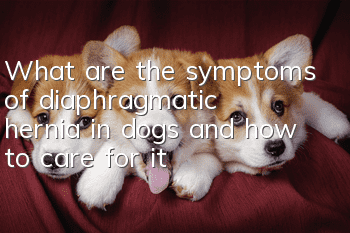What are the symptoms of diaphragmatic hernia in dogs and how to care for it?

Dogs with diaphragmatic hernia will have difficulty breathing
When dogs have diaphragmatic hernia, the most obvious symptom is respiratory obstruction. At this time, the way they choose to breathe may change. They may even have abnormal sleeping patterns, such as being afraid to lie on their sides. The breathing pattern may also change to abdominal breathing. And they dare not exercise, because excessive exercise will also affect their breathing.Dogs with diaphragmatic hernia will vomit
Due to the contents entering the abdominal cavity, the dog may have a loss of appetite, and vomiting may also occur without eating. Accompanied by constipation. Dogs may also experience pain in their abdomen, which can be intense. In severe cases, vomiting of blood may occur.Complications of diaphragmatic hernia in dogs
The herniated intestines and stomach may be torsion, leading to rupture or obstruction. Chronic diaphragmatic hernia may cause pneumonia in dogs.Dogs suffering from diaphragmatic hernia cannot recover on their own, and can only be treated through surgery, which is also the best method for them. Surgery is required to resew the ruptured hernia hole. In fact, the operation is not very difficult. The most difficult part is anesthesia; when the dog's lungs are squeezed, their breathing may be suppressed and the heart suddenly stops. Therefore, when a dog has a diaphragmatic hernia, it is best to Send him to treatment as soon as possible.
How to care for diaphragmatic hernia in dogs
1. Isolate the dog from other pets and put it in a relatively quiet place to avoid external noise from affecting and irritating them, let alone let them carry out activities. Vigorous exercise avoids aggravating the condition and is not conducive to treatment.2. Feed them as little food as possible, especially food that is not conducive to digestion, to avoid squeezing the lungs and causing greater harm to the dog.
3. In order to allow the dog to breathe relatively freely, try to keep them in a posture with the front high and the back low.
4. Reduce the number of times you take your dog for a walk and avoid letting them walk. It is recommended that if you must let them go out, it is best to hold them.
Random articles
- How to tell if your dog is fat? Is your dog overweight?
- Will your dog catch a cold if you blow the air conditioner? What should you do if your dog catches a cold if you blow the air conditioner?
- The dog's mouth bites and shakes. Why does the dog's mouth occasionally shake and bite?
- How to cut a dog's hair? Do you know how to cut a dog's hair correctly?
- Can dogs eat raw eggs? Why can’t dogs eat egg whites?
- Common Dog Problems in Summer How to Deal with Different Dog Problems
- How to keep dogs away from skin diseases. If you do this, will you see if your dog will still be infected with skin diseases?
- What causes anorexia in dogs? Dogs will become anorexic due to lack of exercise. Hounds run at least 5KM every day.
- Can dogs eat liver? What should you pay attention to when giving liver to your dog?
- Can canine herpes virus be transmitted to humans? Owners should not be too nervous



